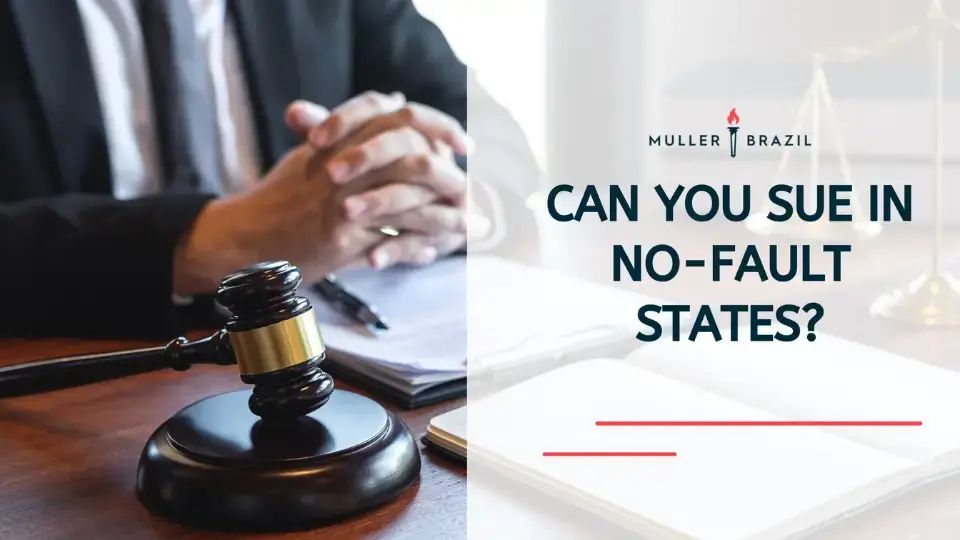7 min read
Navigating Car Accident Claims in No-Fault States
![]() Paul R. Brazil, Esquire
Mar 22, 2024 11:10:21 AM
Paul R. Brazil, Esquire
Mar 22, 2024 11:10:21 AM
In this blog, you will learn how In no-fault states, your insurance covers your medical bills and lost wages after a car accident, no matter who was at fault. This simplifies the claims process and reduces the hassle of lawsuits. However, if your injuries are severe, costs exceed your coverage, or the accident involved criminal behavior, you can still sue for additional compensation. Understanding these rules helps you protect your rights and ensure you get the compensation you deserve. Stay informed and prepared to navigate car accident claims effectively.
What Is No-Fault Insurance?
No-fault insurance is a system designed to reduce litigation by ensuring that after a car accident, individuals can seek compensation for injuries directly from their own insurance companies, regardless of who was at fault.
This system aims to streamline the claims process, allowing for quicker financial support for medical expenses, lost wages, and other economic losses incurred due to the accident. In essence, no-fault policies are structured to provide immediate relief without going through lengthy legal battles to establish fault.
However, the coverage provided by no-fault insurance has its boundaries. While it covers direct economic losses, it typically does not extend to non-economic damages like pain and suffering. Some states offer drivers the opportunity to purchase additional coverage beyond the basic no-fault policy limits, offering a layer of financial protection that can be crucial in a severe accident.
Which States Are No-Fault?
Here's a list to check if your state has this requirement:
- Florida
- Hawaii
- Kansas
- Kentucky (offers a choice of no-fault or some ability to sue)
- Massachusetts
- Michigan
- Minnesota
- New Jersey (offers a choice of no-fault or some ability to sue)
- New York
- North Dakota
- Pennsylvania (offers a choice of no-fault or some ability to sue)
- Utah
In Pennsylvania, Kentucky and New Jersey, drivers can choose between limited tort and full tort insurance options.
Limited tort provides benefits for medical expenses and lost wages regardless of fault but limits the ability to sue for non-economic damages unless injuries meet specific criteria. Full tort allows individuals to retain the right to sue for non-economic damages without meeting these criteria.
This choice impacts drivers' ability to seek compensation following accidents and differs from states with pure no-fault or fault-based systems where such options may not exist.
Delaware, Oregon, and Maryland are called "no-fault states" because they have no-fault insurance laws, which means they operate under a no-fault insurance system. However, unlike the other 12 states with no-fault insurance laws, these states might have variations in the details of their insurance regulations or the implementation of their no-fault systems.
Does No-Fault Insurance Cover Every Issue?
No-fault insurance doesn't cover every issue that may arise after an accident. Here are some of the situations that are not covered:
- Property Damage: No-fault insurance usually does not cover damage to vehicles or other property. For property damage, you may need to rely on collision coverage if you have it or file a claim with the at-fault driver's insurance company.
- Threshold for Lawsuits: In some no-fault states, a threshold must be met before you can sue for damages beyond what PIP covers. This threshold often involves meeting certain criteria related to the severity of injuries, medical expenses incurred, or permanent disability or disfigurement.
- Exclusions: No-fault insurance may have exclusions for certain situations, such as intentional acts, driving under the influence, or using the vehicle for commercial purposes.
- Uninsured/Underinsured Motorist Coverage: This coverage is separate from no-fault insurance but is often recommended. It helps cover your expenses if you're in an accident with a driver who doesn't have insurance or doesn't have enough insurance to cover your damages.
No-fault insurance is meant to get you financial help quickly after a car accident. Instead of fighting to prove who caused the crash, your insurance covers medical bills, lost wages, and other costs. This can be a lifesaver but don't assume you can never sue. Here's why:
- Your policy will have a maximum payout amount. Severe accidents can cost far more than this covers.
- No-fault insurance generally doesn't cover things like emotional distress or long-term disability caused by the accident.
- Each no-fault state sets rules on when you can sue. Often, it comes down to the seriousness of your injuries.
No-fault insurance will usually be your first step after an accident. But if you've been badly hurt, it's important to know your rights regarding legal action.
Contact Us Now
Can You Sue in a No-Fault State?
Despite the primary goal of no-fault laws to minimize court cases related to car accidents, there are exceptions under which an individual can sue in a no-fault state. These exceptions often link to:
- severe injuries sustained
- the extent of economic losses
- the occurrence of specific circumstances, such as intentional acts or criminal behavior during the accident
For example, if an individual suffers injuries that surpass a certain threshold—whether in terms of medical expenses, the nature of the injury, or long-term impairment—they may be eligible to pursue additional compensation through a lawsuit.
Understanding the threshold requirements and the circumstances under which a lawsuit can be brought forward in a no-fault state is necessary. This knowledge can guide individuals in seeking justice and compensation that goes beyond what their no-fault insurance policy covers.
Contact Muller Brazil to find out whether you meet the threshold requirements.
What Are Severe Injuries in a No-Fault State?
Severe injury generally refers to injuries that result in substantial impairment or limitation of a bodily function, require extensive medical treatment beyond basic first aid, or cause significant and permanent disfigurement.
When an individual sustains injuries deemed severe according to the state's threshold, they may have the opportunity to file a lawsuit against the at-fault driver to seek additional compensation for their losses. This legal action is typically pursued to cover expenses and damages exceeding their PIP coverage limits.
Determining whether injuries meet the threshold for severity often requires assessment by medical professionals and legal experts. Medical records, expert opinions, and the individual's statements may be evaluated to establish the extent of the injuries and their impact on the individual's life.
What About High Economic Losses?
Excessive economic losses typically refer to financial damages that surpass the coverage limits provided by PIP insurance. These losses may include:
- medical expenses
- lost wages
- other monetary damages resulting from the accident
When economic losses exceed the state threshold, individuals may have the option to file a lawsuit against the at-fault driver to seek additional compensation. This legal action aims to cover expenses and damages not fully addressed by their PIP coverage.
Determining whether economic losses meet the threshold for legal action often involves assessing the total amount of damages incurred. This assessment may include gathering documentation such as medical bills, wage statements, and other evidence of financial losses.
In cases where economic losses exceed the threshold, the injured party may proceed with legal action, seeking compensation for the excess damages.
This process typically involves presenting evidence of economic losses, negotiating with the defendant's insurance company, or preparing for trial to secure a fair settlement or judgment.
Intentional Acts and Criminal Behavior
Under specific circumstances, individuals can pursue legal action for intentional acts or criminal behavior in a car accident.
Examples of such behavior include:
- Driving under the influence of alcohol or drugs.
- Reckless driving.
- Road rage incidents.
- Deliberately causing a collision.
For legal action to be viable, the at-fault party's behavior must demonstrate intent or criminality and result in significant harm, severe injuries, or death.
These cases typically involve exceeding thresholds set by state law, such as thresholds for severe injuries or substantial medical expenses.
Suing for Pain and Suffering in No-Fault States
When it comes to suing for pain and suffering in no-fault states, the process is governed by specific criteria defined by specific state laws. These criteria often involve meeting certain thresholds related to the injuries' severity or duration of impairment.
Some no-fault states have implemented "verbal threshold" laws detailing the types of injuries qualifying for pain and suffering beyond the standard no-fault benefits. For example, individuals may be able to sue if they suffer significant and long-lasting injuries that impact their ability to lead their normal lives, such as walking, working, or caring for oneself.
Given the complexities involved in pursuing such claims, legal representation becomes invaluable. An experienced attorney can help you through the legal requirements, ensuring that individuals pursue all eligible damages and receive the compensation they deserve for their suffering.
Rights of Passengers in Not-At-Fault Accidents
Passengers injured in not-at-fault accidents have the right to seek compensation, regardless of the no-fault or fault-based nature of the state. They have the option to claim compensation from the insurance of the at-fault driver.
Passengers can explore compensation through their personal insurance policies or proceed with a lawsuit against the at-fault driver if the accident occurred in a fault-based state. Understanding their rights, passengers can be sure they are adequately compensated for their injuries and any losses sustained due to the accident.
Filing a Lawsuit in No-Fault States
Filing a lawsuit in a no-fault state requires meeting certain legal thresholds. These may include:
- demonstrating severe injuries
- significant economic losses
- particular circumstances as outlined by state law
The procedure for filing a lawsuit may involve submitting a formal complaint, attending court hearings, and engaging in settlement negotiations. See our blog on how long a lawsuit takes for more information.
Seeking the counsel of an experienced car accident or insurance attorney can provide extremely helpful insights into the feasibility of a lawsuit in a no-fault state. Legal expertise can increase the likelihood of a successful outcome, helping individuals in the legal system and advocating for fair compensation.
Seeking Legal Representation
Dealing with the aftermath of a car accident in a no-fault state can be extremely difficult. Legal representation can offer much-needed guidance through the insurance claim process, negotiation with adjusters, and advocating for fair compensation.
Attorneys with knowledge of no-fault laws can help clients understand their rights and evaluate the strength of their cases. This peace of mind allows you to focus on maximizing your recovery. Working with a skilled attorney reduces the stress of legal proceedings.
Conclusion
While the no-fault system aims to streamline compensation and alleviate the burden on individuals involved in accidents, there are instances where legal action may be necessary to seek full and fair compensation.
Understanding the thresholds and exceptions in your state's laws is crucial. Whether you exceed the threshold for severe injuries, demonstrate intentional acts or criminal behavior, or meet verbal thresholds for pain and suffering, there are avenues available for those who have suffered significant harm.
It's important to remember that behind every legal case are individuals who have endured physical, emotional, and financial challenges. If you are in such a situation, don't hesitate to seek guidance from legal professionals who can provide compassionate support and proactive advocacy on your behalf.
FAQs
What is the difference between comparative fault systems vs. no-fault?
Comparing fault-based and no-fault systems highlights key differences in legal procedures following a car accident. In fault-based states, establishing fault and proving liability are necessary for recovering damages. No-fault systems allow individuals to seek compensation directly from their own insurance companies without determining fault.
What if my medical bills exceed my no-fault coverage?
This is a common situation in which you might consider a lawsuit. Consult with an attorney to see if you meet your state's requirements for suing.
Does "no-fault" mean I can't sue for pain and suffering?
No-fault typically covers economic losses but not emotional distress. Some states, however, allow lawsuits for pain and suffering with severe injuries.
What's considered a "serious injury" for being able to sue in Pennsylvania?
PA law doesn't give a clear-cut definition. It's best to consult with a Pennsylvania attorney to see if your injuries qualify.
Should I hire a lawyer even if I just file with my no-fault insurance?
Getting legal advice early on is not always necessary, but it can be extremely valuable. An attorney can help you understand your coverage limits and whether you have a potential case if your costs are high.
Meet the Author
Paul Brazil - Founding Partner
Paul Brazil is a native of Dunmore, Pennsylvania and a graduate of Dunmore High School. For his undergraduate education, he attended Bloomsburg University where he majored in political science. He then went on to earn his JD from Widener University School of Law. Following graduation from law school, Mr. Brazil worked at a large Philadelphia civil defense firm where he litigated workers’ compensation claims and Heart and Lung Act cases.
Learn more about Paul Brazil ⇒






